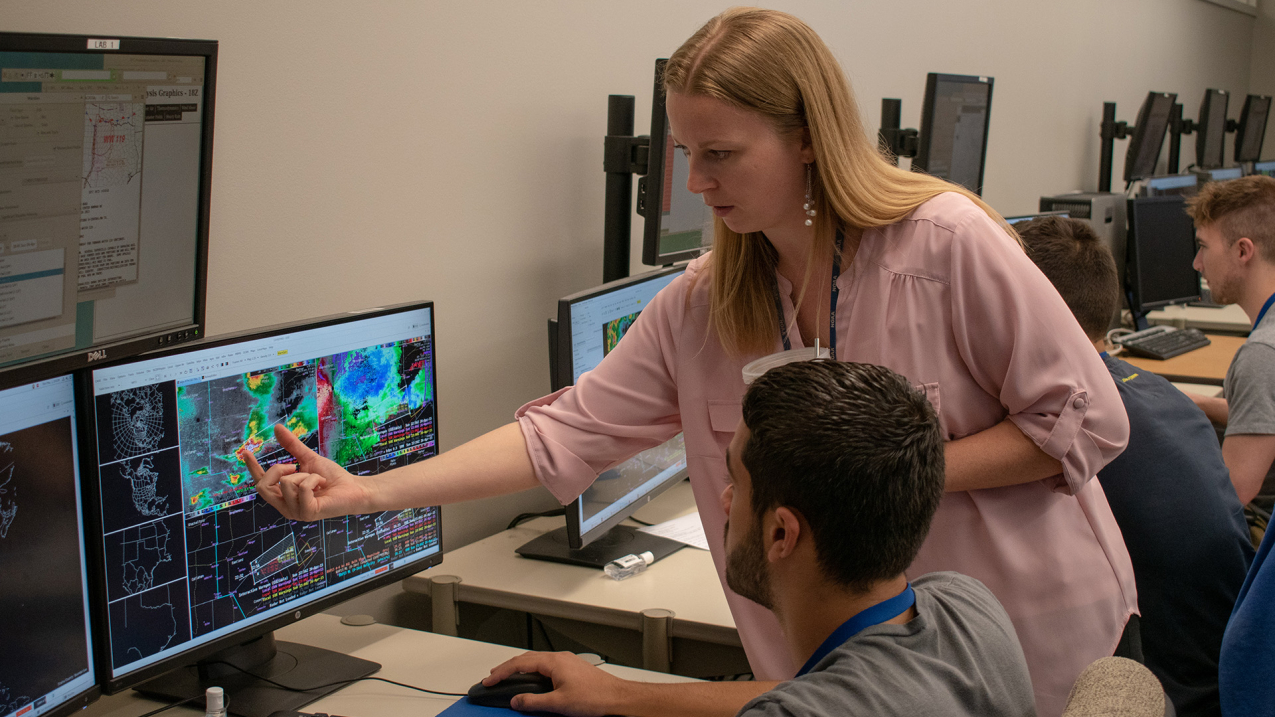Huddled around computers, teams of meteorologists-in-training carefully analyzed data from radar, satellites, and other observing systems. Telltale signs of severe thunderstorms appeared on their displays, tracking toward Dallas. As the storms intensified, these students faced several key decisions: should they issue a severe thunderstorm warning, a tornado warning, or do nothing?

In 2019, University of Oklahoma School of Meteorology Student Ryan Cumming participated in a severe weather simulation used to train all National Weather Service forecasters. He was one of 26 students who took the "Application of Theory to Severe Thunderstorm Forecasting" course. CIMMS Researcher Jill Hardy supports the NWS Warning Decision Training Division training and points out some areas to Cumming that he should focus on. (Image credit: Emily Summars/University of Oklahoma Cooperative Institute for Mesoscale Meteorological Studies/NOAA)
Although this was only a simulation, the students were riveted to their monitors, their expressions almost as tense as if they were making real life-or-death decisions. Becoming a meteorologist, after all, not only requires mastering the science of weather prediction, but also learning to cope with the high stakes of operational forecasting.
Based on an exercise designed for National Weather Service (NWS) forecasters, this training for University of Oklahoma (OU) School of Meteorology students was led by NOAA’s Cooperative Institute for Mesoscale Meteorological Studies (CIMMS) at the NWS Warning Decision Training Division. In spring 2019, OU students issued warnings in quasi-real time based on a past tornado and severe thunderstorm event in Texas. They were exposed to the process — and the stress — that forecasters face when issuing warnings for events such as tornadoes, severe thunderstorms, and flash floods.
“The simulation tested our understanding of radar meteorology and how to identify and ‘nowcast’ severe thunderstorms and tornadoes,” said OU meteorology graduate student Amanda Murphy. “It was enlightening to not only work with the software, but also have a simulation running in real-time and experience the pressure and quick decision-making that NWS forecasters experience every time they work a severe weather event.”

Students gained forecasting experience with the same software used at NOAA and practice communicating scientific information to the public clearly and concisely. The training was also an opportunity for students to shadow a day-in-the-life as a NWS forecaster to find out if that career path appeals to them.
This training was “the icing on the cake for the end of the semester,” said Eric Jacobsen, Research Associate at CIMMS. Jacobsen’s career has come full circle since he took the same course at OU during his graduate studies five years ago. He now trains new staff with NOAA’s NWS Warning Decision Training Division in Norman, Oklahoma.
“The OU course helped me learn how meteorological theories relate to applications, like issuing warnings, and this takes it a step further with hands-on experience,” Jacobsen said. “This is a great example of how the School of Meteorology, the NWS, and CIMMS collaborate on opportunities for students and share our expertise.”
At the end of the semester, these students were one step closer to becoming the next generation of confident weather forecasters. As Murphy explained, “Learning concepts in a classroom is one thing, but these hands-on experiences really help drive home concepts and cultivate real passion for both the science and serving the public.”
A version of this story was featured in the Fiscal Year 2019 NOAA Education Accomplishments Report.



